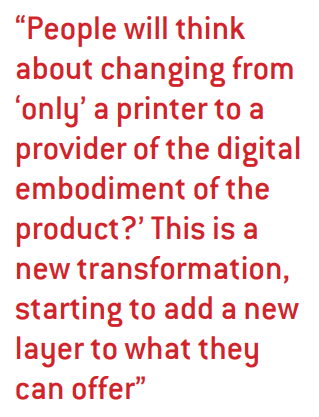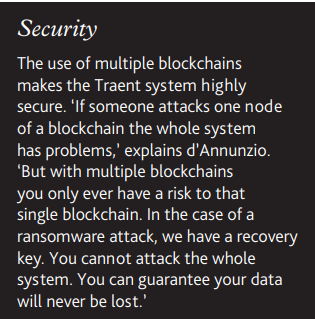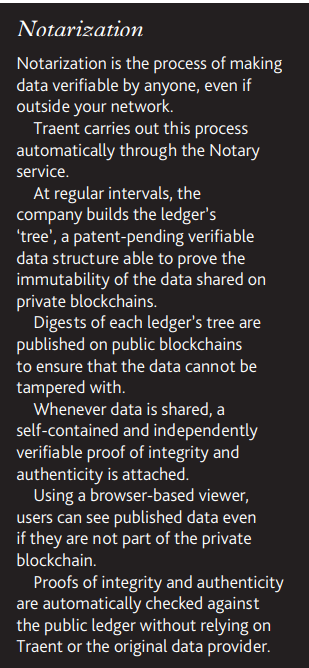Blockchain breakthrough
A new blockchain technology is set to revolutionize the secure exchange of data through the label supply chain

Federico d’Annunzio
A user-friendly blockchain technology developed by industry veteran Federico d’Annunzio, through his new company Traent, aims to transform the label into a secure information super-highway, changing forever the way supply chains operate and goods are sold.
Blockchains are basically ledgers that record transactions between two parties or between two systems (or nodes). The ledgers are authenticated by multiple computers on a distributed network, and all these computers must agree that the ledger is authentic and has not been altered. This makes it a highly secure way of storing and exchanging information, pretty much invulnerable to attack.
How might this be applied to labels?
‘Digital embodiment’
D’Annunzio’s visionary concept is that digitally printed QR codes act as gateways to almost limitless amounts of real-time information encrypted in blockchains and made available to view on secure browsers.
The label becomes, in d’Annunzio’s words, the ‘digital embodiment‘ of the product.
The label converter stores different streams of data about the label in multiple blockchains, and exports a subset of that data into a database which can then be viewed by outside parties.
This is critically important: the label converter chooses what data remains confidential in the blockchain and what data is made available for viewing. Also, the converter gets to choose who views which parts of the data.
The type of data the converter chooses to encrypt and make available could cover a wide range of information critical to the efficient functioning of the wider supply chain.

For example, the brand owner might be allowed to access information on the materials used in the manufacture and printing of the label, the date the finished roll is available for dispatch, any certifications required and the total energy footprint of the label.
‘You can add data from different blockchains to that QR code,’ explains d’Annunzio. ‘By scanning the QR code and/ or an RFID tag the quality control inspector can now see when the label was printed, the quality certificates, when the customer was billed, what materials have been used, and so on.’
A more extensive range of information could be made available to a brand’s audit team, such that physical auditing of label plants becomes unnecessary. ‘All this information will be available in real-time and the delivery will be completely automated,’ points out d’Annunzio. ‘And there is no need to check the data, which is authenticated by the blockchain.’

The QR code gateway to the blockchain has further value upstream of the label converter. For example, it could provide time-stamped confirmation when the label is applied and provide a unique identifier for product authentication and track and trace applications.
If the packing plants and warehouses are on their own blockchains, these can intersect with the converter’s own blockchains to create a fully transparent supply chain. The result is a massive reduction in cost, waste and time to market.
‘The label printer with a digital press brings the brand owner into the new world of interoperability. This is a completely new offering to brand owners. This is no longer “only” a label, but the digital embodiment of the label,’ says d’Annunzio. ‘The label becomes a gateway to a wider world of real-time data. A label carries a unique Digital Product Passport, featuring the past, present and future of every single product. Creating additional product value and being compliant with the future mandatory EU norms on traceability, effective starting in 2024.’
How does it work?
D’Annunzio’s team at Traent has made the blockchain workflow as easy as possible for label converters to use. ‘You can develop your own blockchain workflows in-house without any blockchain skills,’ says d’Annunzio. ‘We have created editable workflows where you create your own blockchain with one click. You can easily create and exchange data – it is just a standard web interface like you would find on Google Drive or Microsoft Office. This is a democratization of blockchain. You do not need to code anything.’

The blockchain workflow interfaces with a user’s standard IT system using APIs [Application Programming Interface]. D’Annunzio says there are no limits to the number of blockchains that can be created.
‘I have a node and you have a node and that creates a blockchain. Also, we are platform agnostic and can put data onto any blockchain.’
The workflow acts as a risk management tool because the label converter can decide what information is made available, and to whom. This means there is no danger of disclosing confidential information – which also means the system is GDPR-compliant.

‘You segregate the information you want to keep hidden and aggregate the information you want to make public. You make things private or transparent as you want,’ explains d’Annunzio.
Data export from the blockchain can take place in real-time from IoT sensors and blockchain nodes – what d’Annunzio calls a ‘living blockchain.’
This means processes can be continuously monitored.
‘Energy consumption in the factory or on a press can be transformed into a blockchain node. All this data is time-stamped and on the blockchain, so cannot be changed or altered.’
For example, if a converter has GEW lamps on its press, GEW can add a small inexpensive box that takes the real-time data from the lamp that then creates a new blockchain where the information is accessible to the converter, and anyone else the converter chooses to allow access to it.

Continues d’Annunzio, ‘At the moment we are the only ones who can do this because we have spent two to three years in development. Nobody else has real-time collaboration and nobody else can create blockchains and export files so you can see that data on a website. All these things we developed because I know the business. I put these assumptions on the table at the beginning.’
For the brand owner, there is a deep seam of data to be mined. They can be informed when each label is applied to a pack, and match that to a material with its full specifications, while an inspection system could match the label and the roll to the original file.
The label can continue to deliver critical data after the product has been used.
‘The waste product can be tracked, and you have visibility of the recyclability of the package itself. The label can tell you how many times a bottle has been reused. It’s a never-ending process,’ says d’Annunzio. ‘The label is the sum of all these interactions. And you can enter the metaverse much more easily since the label is already a means to reach every kind of information.’

Currently, d’Annunzio is involved in a pilot project to place a complete supply chain onto the blockchain.
‘We are demonstrating risk management along with visibility of the whole supply chain. There are a total of 10 blockchains. We are also working with utility companies, medical device suppliers plus several enterprises in the automotive, luxury goods and foods and beverage industries.’ The project is now ready to be rolled out to the label industry.
D’Annunzio is confident that the entrepreneurial nature of the label industry means it will quickly grasp these new opportunities. ‘I’m sure that people will start to think “how can I change my role from ‘only’ a printer to a provider of the digital embodiment of the product?” This is a new transformation, starting to add a new layer to what the label converter can offer.’
Stay up to date
Subscribe to the free Label News newsletter and receive the latest content every week. We'll never share your email address.


